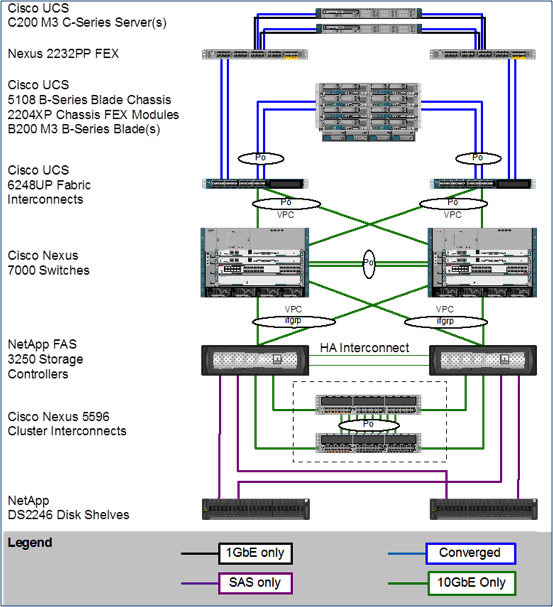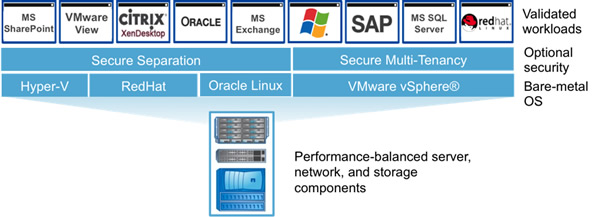


The FlexPod® platform is on fire. According to Gartner, FlexPod is currently the dominant reference architecture in the converged infrastructure market. To date, the data center platform from NetApp and Cisco has been deployed by more than 2,500 customers in 35 countries. Many are now deploying additional FlexPod platforms, standardizing on it for mission-critical applications. That's pretty impressive for a platform that was introduced in late 2010.
The secret lies in the fact that FlexPod delivers the performance, scalability, and availability that today's data centers need, in a package that's flexible and easy to deploy and manage. We've been moving aggressively so that FlexPod continues to keep ahead of developments across the IT world.
In this article, we discuss recent FlexPod evolution and look at how companies of all sizes are making FlexPod the core of their operations—particularly for mission-critical business applications.
FlexPod Enhancements

NetApp and Cisco have been steadily enhancing FlexPod capabilities and adding broader support for important applications so that FlexPod can meet the broadest possible range of IT needs and run the most business-critical applications. Back in October, we added FlexPod support for the clustered Data ONTAP® operating system and released a validated design for virtualization of Oracle® RAC databases. In addition, we launched the FlexPod Express™ platform to address infrastructure needs in small and medium-sized organizations.
In January, we announced an initiative for deeper architecture integration between NetApp, Cisco, and our technology partners to create a common foundation for data centers capable of spanning from branch office installations and satellite data centers to multi-data-center deployments. This initiative includes FlexPod solutions focused on meeting the needs of cloud service providers, Flexpod Express configurations targeted for branch office needs, and broader support for mission-critical applications.
This month (April 2013) has seen a lot of FlexPod activity on both the infrastructure and the enterprise-application support side that is moving these initiatives forward.
Infrastructure Enhancements
The core FlexPod platform has been enhanced with support for VMware® vSphere® 5.1 and Cisco® UCS™ Manager 2.1. This updates the existing FlexPod architecture to allow you to do end-to-end (multihop) FCoE. (Some connectivity changes will be needed but no new switches or blades are required.) Support for UCS Manager 2.1 also enables compatibility with UCS Central, which lets you manage numerous Cisco UCS instances across globally distributed data centers (10,000+ individual servers).
FlexPod now includes validation for Cisco Nexus® 7000 Series switches for IP-based storage. The Nexus 7000 can replace the Nexus 5000 for larger-scale deployments that need higher port density. It's ideal for multisite, highly scalable infrastructure designs and includes the following.
- In-Service Software Upgrades (ISSU) and Stateful Switchover (SSO) let you upgrade your network with zero packet loss for higher network availability. Fabric features such as ISSU, combined with clustered Data ONTAP features, provide FlexPod-wide nondisruptive operations and virtually eliminate planned downtime.
- The Unified Port enables multihop FCoE solutions with UCS 2.1, expanding unified fabric beyond the first hop to create a true “cable-once” data center.
- OTV and LISP provide data center interconnect support to enable VM mobility across several data centers. The Cisco LISP Virtual Machine Mobility solution allows any host to move anywhere in the network while preserving its IP address. OTV allows the secure extension of Layer 2 connectivity across numerous locations.

Figure 1) FlexPod IP storage-based connectivity with Nexus 7000 and clustered Data ONTAP.
These enhancements give FlexPod an even higher level of integration. It's quickly evolving to allow you to have several data centers of equipment all interconnected so you can scale up and scale out to deliver the performance and availability that mission-critical applications need.
Here are the latest design documents (updated in April 2013) that include UCS 2.1, vSphere 5.1, and end-to-end FCoE.
- VMware vSphere on FlexPod Design Guide
- VMware vSphere 5.1 on FlexPod Clustered Data ONTAP Deployment Guide
- VMware vSphere 5.1 on FlexPod Data ONTAP Operating in 7-Mode Deployment Guide
New Enterprise Workloads
We're also rolling out support for a variety of enterprise software with new Cisco Verified Designs (CVDs), NetApp® Verified Architectures, and solution guides. Our goal is to provide ever-greater support for the software your business relies on.
A variety of new validated architectures are coming for Microsoft® environments.
- FlexPod:
- Microsoft Private Cloud Fast Track 3.0 validation
- FlexPod with Microsoft Private Cloud Design Guide
- FlexPod with Microsoft Private Cloud CVD (coming soon)
- Flexpod Express with Windows Server 2012 Hyper-V
And, we're continuing to expand validation work for mission-critical workloads in conjunction with Oracle. Upcoming designs include:
- Oracle on FlexPod with VMware
- Oracle JD Edwards EnterpriseOne on FlexPod Design Guide
- Oracle on FlexPod with Oracle Linux (June 2013)—bare-metal deployment
These solutions give you more options for deploying Oracle and Oracle solutions on FlexPod. This Oracle blog and this NetApp blog have more details.

Figure 2) FlexPod supports an expanding environment of both infrastructure software and mission-critical business applications.
Keep an eye out for further FlexPod enhancements coming in June and throughout the year.
Powering Mission-Critical Applications

When it comes to mission-critical applications, availability, performance, and scalability are key. FlexPod delivers availability first by eliminating single points of failure. Every component is redundant. The addition of the Nexus 7000 extends that vision; in the near future you'll be able to do more than just fail over FlexPod platforms between sites. The vision is a data center fabric that extends across numerous sites but binds them together into a single virtual, distributed data center that can be managed as a whole.
A big part of availability these days is eliminating planned downtime. Virtualization makes it possible to move applications off hardware that requires maintenance or upgrade without disrupting operations. Recent FlexPod enhancements like support for clustered Data ONTAP and Nexus 7000 switches give you even more capabilities to avoid planned downtime.
With the scalability that FlexPod provides, you can size deployments to meet business performance and capacity needs without overprovisioning or wasting resources. Because growing a FlexPod platform is easy, there's no need to overprovision up front.
Unlike with many other converged infrastructure solutions, you can add server, fabric, or storage components. For instance, you don't have to buy additional storage if only server resources are required. The FlexPod architecture scales up to meet business needs without being bound by inflexible architecture constraints.
You can also opt to scale out with a second FlexPod configuration. Many customers are improving procurement and deployment efficiency by ordering complete FlexPod units. For example, one company successfully deployed 1,500 VDI desktops on a single FlexPod rack. When it came time to deploy another 1,500 desktops, the team deployed a second FlexPod unit identical to the first, saving months in planning, procurement, and deployment time.
Because of these capabilities, companies of all sizes increasingly trust their core business operations to FlexPod.
Midsize Healthcare Provider Runs on FlexPod
A 2,800-employee U.S. healthcare provider was struggling with an IT solution that was aging and underperforming. The IT team needed a flexible, shared infrastructure that would be better able to support SLAs, enhance performance of mission-critical applications, improve operational efficiency, lower costs, and eliminate planned disruptions.
They overhauled both their data centers by implementing FlexPod and virtualizing 95% of the IT environment on Citrix XenServer. (The remaining 5% runs on specialized imaging equipment and can't be virtualized.) Today they run 371 virtual servers.
This FlexPod environment already includes Cisco Nexus 7000 switches. The team deployed the 7000 now for the increased port density and so they'll be well positioned to fully interconnect the FlexPod platforms running in each data center.
Like many of your data centers, this data center already had many of the components required to build a FlexPod unit, including a Nexus 7000-based data center fabric. Unlike those with more rigid data center architectures, the IT team was able to repurpose existing devices and build a new, lower-cost data center while realizing all the benefits of the integrated FlexPod platform.
This provider has virtually all its mission-critical applications running on FlexPod, including its entire medical record system, charting, HR, much of its imaging and radiology, and even things like its VoIP system. If FlexPod is offline, 14 facilities are offline and lives are at risk.
The results are impressive. The provider has seen an order of magnitude improvement in performance on mission-critical applications; overall application performance has improved six to seven times. Access times for charting have gone from 3 minutes to under a second. Report completion has dropped from 2.5 hours to a few minutes. As a result, the medical staff has seen great improvements in productivity and the IT staff has improved productivity as well.
The overall data center footprint was reduced by 95% with over $200,000 in annual savings on power and cooling. Applying NetApp storage efficiency technologies such as deduplication netted the provider additional savings by recovering 36% of the capacity on appliance servers.
Accounting Firm Boosts Productivity
A top-100 public accounting and professional services firm turned to FlexPod when it outgrew its five-year-old IT infrastructure and needed to add replication to protect sensitive data.
Recently named one of the 50 most efficient and fiscally successful accounting firms in the United States, this 275-employee company has only 2 people supporting all data center infrastructure. Accounting professionals rely heavily on core software applications for everything from tax and audit preparation to workflow and time and billing management. The firm also relies on several databases and a customized SharePoint® system that serves as the hub of all document management for 16,000 client sites.
The company virtualized its core accounting software and Microsoft databases on FlexPod running VMware®, and it will virtualize Exchange as well. Most of SharePoint is also virtualized. The primary node for the Microsoft SQL® database used by SharePoint is on a physical server with a passive node on VMware.
Implementing a new replication strategy with NetApp SnapMirror® software has significantly enhanced the company's ability to recover data and operations. The recovery time objective is down from 48 to 2 to 4 hours. The recovery point objective has been reduced from 24 hours to less than 1 hour. A second, smaller FlexPod configuration is being implemented at a colocation site to further enhance disaster recovery.
The impact of these changes has been immediate and significant. Incremental data searches now take less than three seconds compared to two to three hours with the previous systems—a 95% reduction in the time required to obtain customer information. Data can now be uploaded quickly and associated with a particular client. Each record is instantly searchable for improved content management and better customer service. These changes have significantly improved the productivity of the company's accountants.
Conclusion

Both of the companies described above are running all their mission-critical applications on FlexPod. The two companies are vastly different—the healthcare provider has 10 times more employees—but FlexPod is able to address the needs and requirements of both while delivering great availability, big improvements in application performance and employee and IT productivity, and the scalability to meet future needs. Perhaps it's not surprising, then, that a recent Forrester study of total economic impact showed an expected ROI for FlexPod of 120% within the first 9 months.
NetApp and Cisco continue to enhance FlexPod to offer the capabilities that modern IT requires and verified designs that allow you to deploy and run leading business applications faster and with better results.






